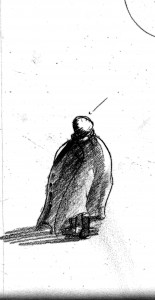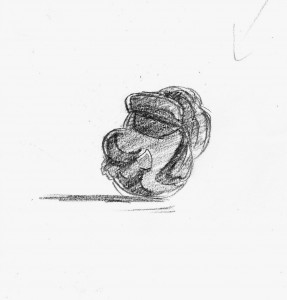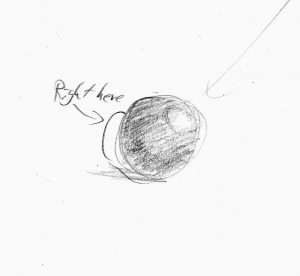Hey Art Nerd,
I have taken up sketching recently, and I’m getting better at line work. The shapes are starting to come out on the page like they are in my head, know what I mean? But I’m having a hell of a time trying to show what things are supposed to be. How do you draw cloth that looks like cloth, or skin that looks like skin, or metal that looks like metal? My cloth and metal and skin all basically look the same.
Thx.
–Robin Q.
***
Robin:
You give up.
Nah, not really.
The thing to remember is that different materials have different ways of reflecting light. Some do, some don’t, and some sorta-do-but-not-really-and-are-kind-of-lazy-about-it.
Firstly, you need to put in a bit of light. I.e., some kind of light source.
Then you add your material of choice. And then this is where things get a little tricky. When you have a material such as skin or cloth, you need to remember to make it get shaded by light. The shading is gentle, smooth and continuous, though for cloth you have to add a lot of little shadows where it folds.
There we go. If you want to add more detail, then go right on ahead. Add more details. Add bits of pattern. Make sure you repeat it so that your cloth looks cohesive. Or you could, you know, not give a damn and just scribble all over it.
Now, let’s go to…say…metal. Metal has a thing with liking really hard changes from extreme light to extreme dark. It’s kind of like cel-shading with a little gradient.
This makes it difficult to draw metal without it looking like crap. The points that are closest to the light must have the whitest spots, and points that are furthest…actually, let’s get to that, because that’s another point of trickiness.
You see, light has a tendency of bouncing off of everything. Take a rubber ball (or steal one from a “friend” of yours) and put it on your desk or table or whatever. Leave most of the room dark, and turn on one lamp near your ball. If you notice, it isn’t totally dark on one side. Instead, it’s actually lit on the side that’s furthest away from the lamp, because light is reflecting off of the surfaces behind the ball.
In fact, you might say that the way that light reflects off the back is kind of…shady.
So keep this in mind for metal – the side away from the light won’t be completely dark, it’ll have some light reflected into its shadows. In fact, keep that in mind for everything. Kinda important, dontcha know?
And as a bonus, let’s go to leather. Now, leather is kind of in a strange place. It’s reflective, much like metal, but it also has a kind of greyness to it similar to cloth. You need to remember that you can go to extremes with leather, but you also need to have more of a gradient.
…actually, that really doesn’t help describe it. Here. have a picture.
Unlike metal, you can see that there’s a little leeway before it starts turning darker, but it still goes from light to dark to really dark quickly.
In the end, you just need to keep practicing. Remember what Chuck Jones said: “Dogwood. It’s worse than its blight.”
Oh, and something about getting a thousand bad drawings out of you now. If you want to, you can find all kinds of tutorials on this all throughout the internet. There are plenty of helpful artists on conceptart.org that can really help you become less terrible.
Just don’t go to that site expecting constant praise. They have high expectations there. And they don’t take shading… lightly.
Over ‘n out,
The Art Nerd
Got an art question? Ask the Art Nerd! asktheleagueofnerds@gmail.com
Twitter @AskTheLeague / facebook.com/asktheleagueofnerds





